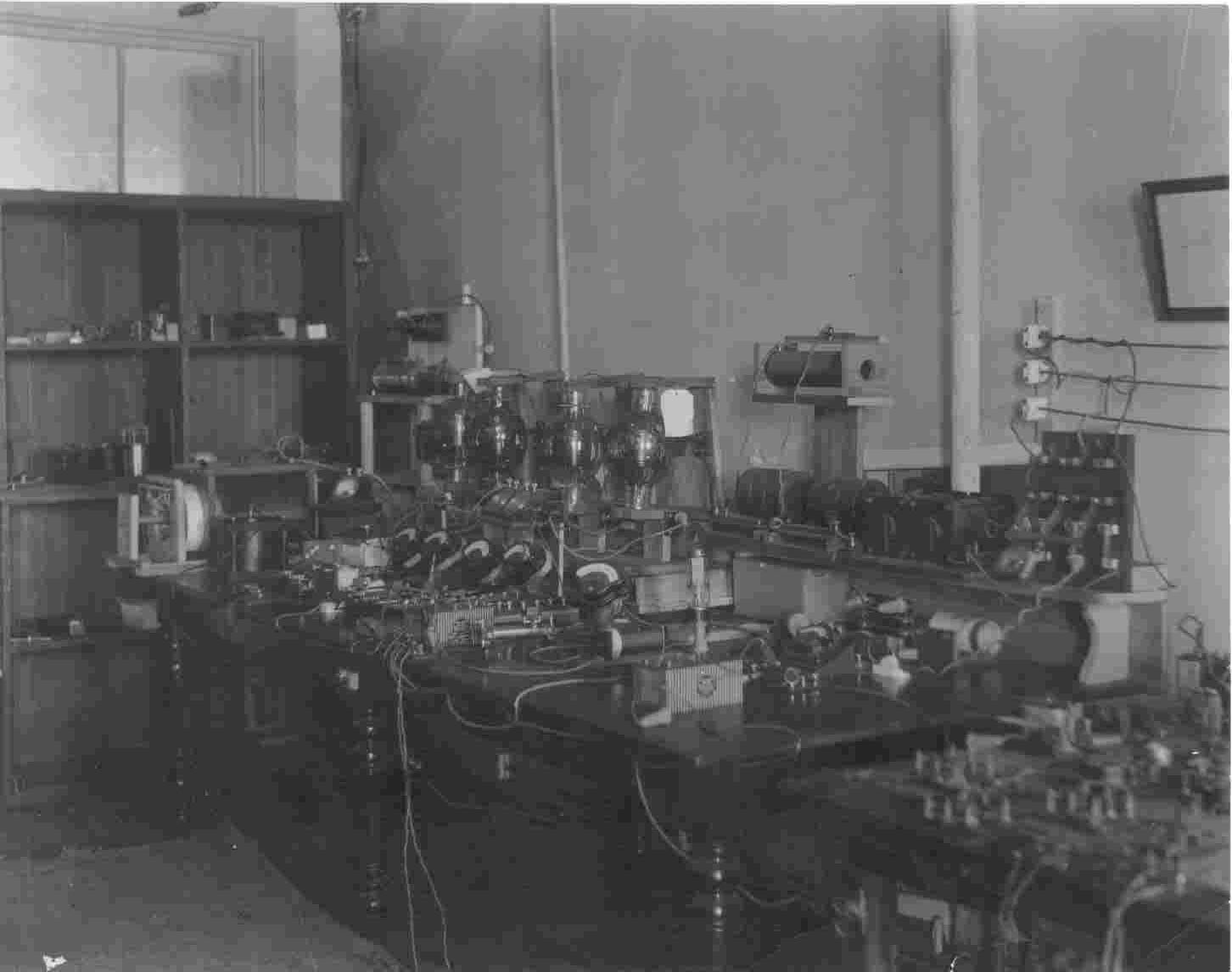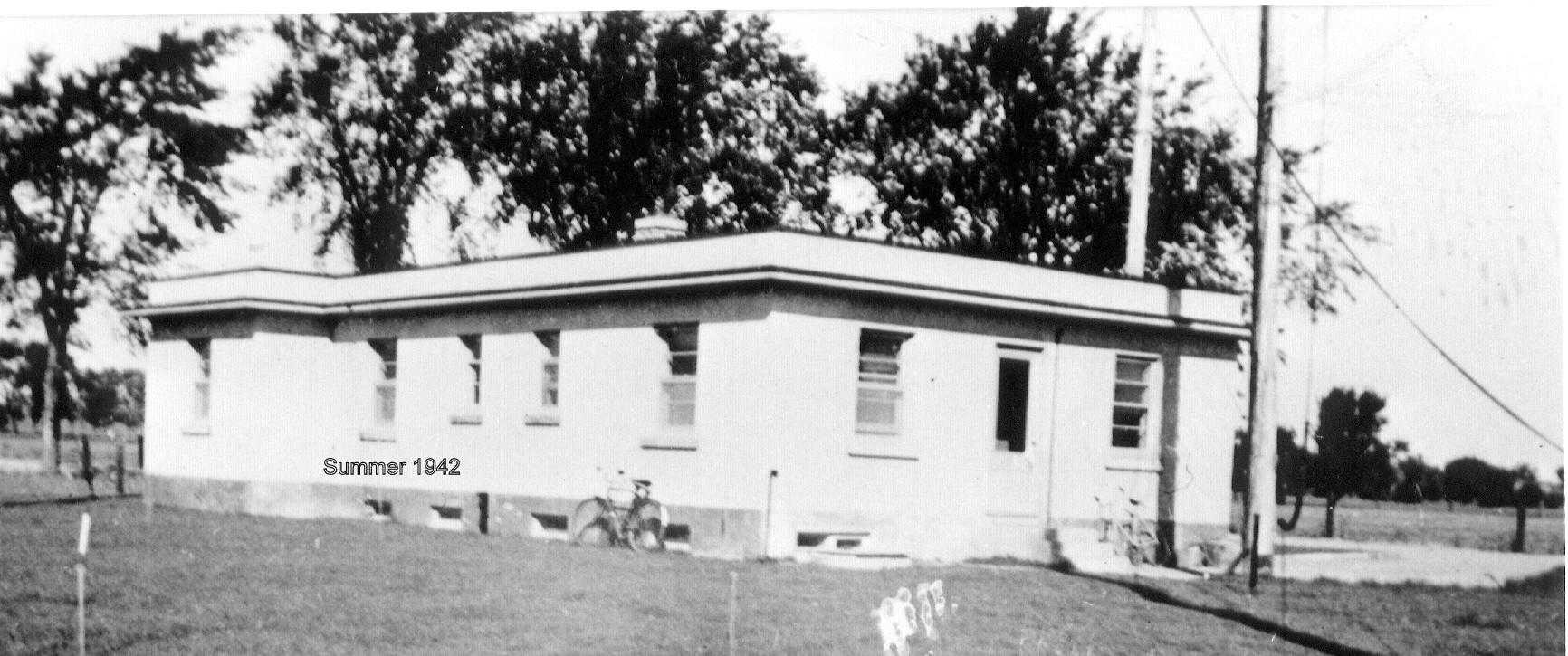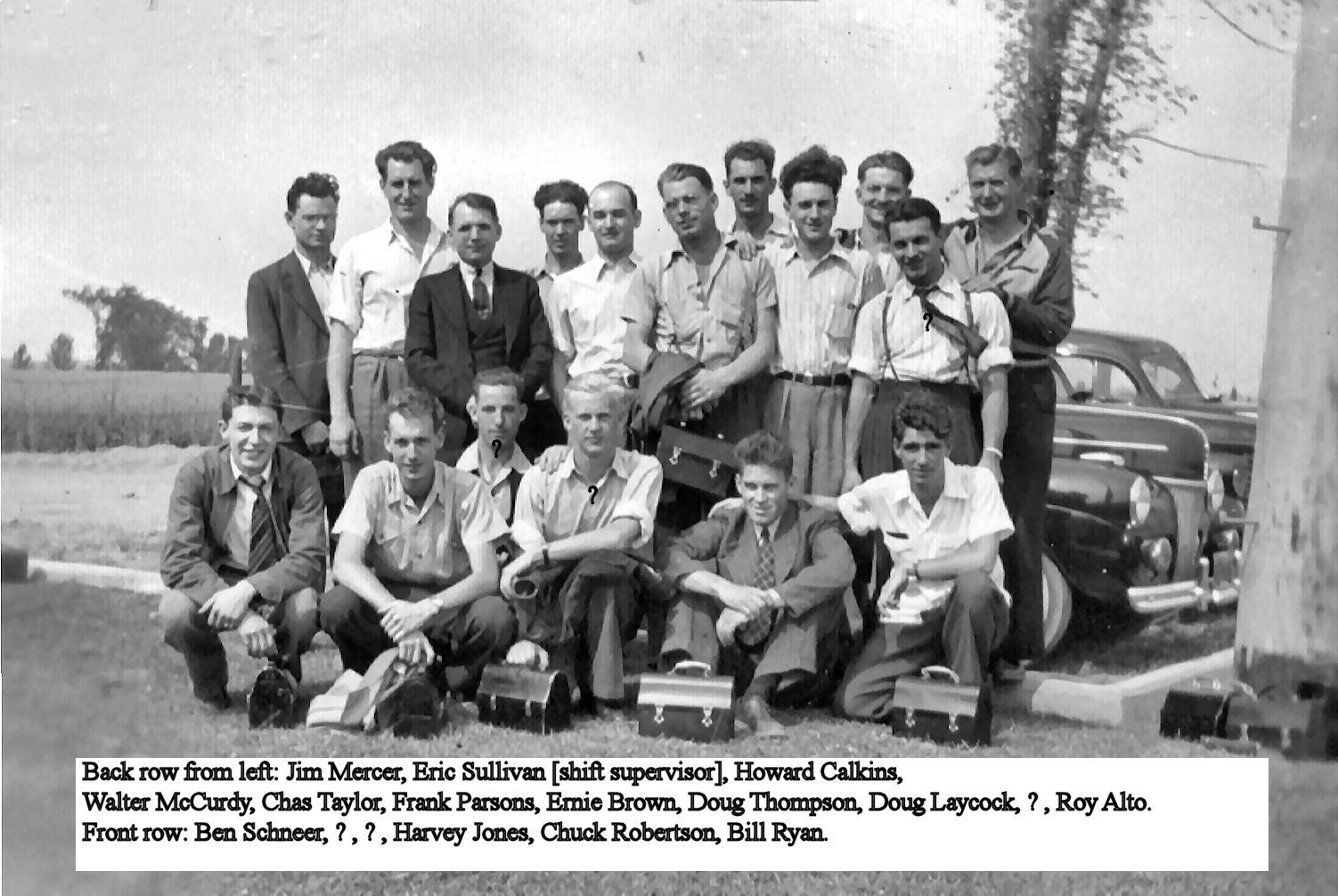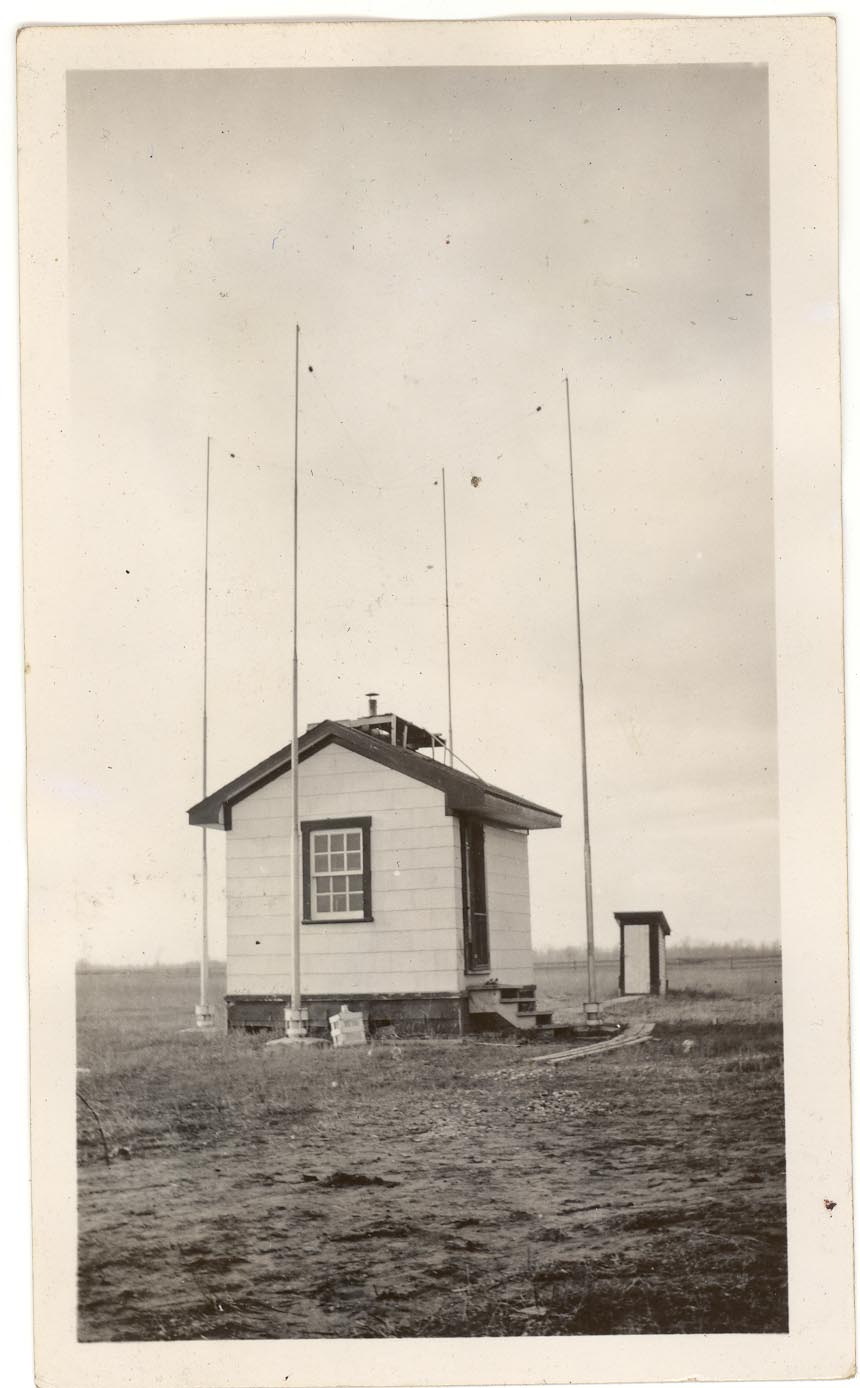
|
The Ottawa Monitoring station
History
The first monitoring station, it was established in 1931, at 299 Wellington Street, in what was then called the Radio Test Room.
About 1934, those facilities were moved to the Experimental farm and remained there until 1941 when a brand new station was built to house the numerous operators ( 125 ) engaged in ' Y ' activities during war times.
Ed Davey, in a report to J.W. (Bill) Wilson, recounts how it came about and some of what went on there.
Bill Wilson also has recollections about the activities carried out at the Ottawa Monitoring Station.
Ernie Brown, on his web site, adds some information
And Lloyd Cope, who was one of those sparks there adds some more on how it was..
Those facilities were moved to Almonte, Ont. in 1955 with Ed Davey as O.I.C.
Roll call
Those radio operators on duty during WW II - much is missing . Lloyd C. says there were at least 6 girls operators, one of them got to be a nun after the war, who can come up with that info ?
Go down this page for more info on some of the radio operators who worked at the Ottawa Monitoring Station.
Special
Walter Howard, a cartoonist who apparently migrated to 'Y' Ottawa operations from the Star, rendered these cartoons .
Photo album thanks to Ernie Brown, Lloyd Cope, Charles Taylor and others
Humble beginnings at the Radio Test Room
On Merivale Road The new building had operating positions for about 18 monitoring operators, plus a teletype position, the DF in a separate building, and the VAA station and the Frequency Standard in other rooms.
The HuffDuff hut with its necessary partner ! The DF was a Bellini-Tosi goniometer system with vertical Adcock antennae in place of the crossed loops normally installed on a ship. Receivers at Ottawa were National HRO. The DF at St. Hubert was the same, and a similar DF had been installed at Hartlen Point on the east coast. They all contributed to the success of tracking German U-Boats and other vessels. The 'mobile' transmissions were normally just one code group of five letters and fast reaction was required. The monitoring operator would recognize a different signal from that of the German coast station and immediately alert the DF via the interfone identifying the channel, at the DF the operator had to check if the correct coil was in the HRO, change it if necessary, and spin the dial to the correct dial setting, (these had to be memorized), and when the signal was heard, swing the goniometer for a quick bearing. By this time the mobile transmission would be at the second or third last character and very seldom could we get a second swing of the goniometer to refine the bearing. So the report would be 'Class C bearing xxx'
Ottawa 'Y' station Charlie Custance remembers: He had graduated from Canadian Electronics Institute in 1940 and had gone to sea on a Dutch ship. They made one round trip to the UK without problems, but on the second trip the vessel capsized in a storm. Only those out on deck survived and he was lucky to have been on deck. They were rescued by a Swedish vessel. He reported to Ottawa Mar. 3, 1941 with Harry Richardson and they worked in the old farmhouse until the new station was occupied. After the war years he was at the Winnipeg Monitoring Station, and later at Winnipeg Airport. He retired in Winnipeg, Man. [Deceased 2003 ?]
Rod Stewart remembers: He had graduated from Canadian Electronics Institute in 1941 and reported to Ottawa April 15th. He worked at the old farmhouse until Sept./Oct. 1941 when he spent two months at St. Lambert, PQ. 'baby sitting' a Dorval Transmitter site. This was followed by two weeks of DF training at St. Hubert, then returned to the new station in Ottawa on Dec. 11, 1941, where he rotated with Lloyd Cope on the TT and DF positions. He noted that in June 1942 there were 105 operators. In Nov. 1943 he reported to St. Hubert DF station as OIC until 1945. He recalls one thunderstorm when lightning flashed across the front of the DF equipment racks, he hit the floor and supervisor Jack Wyatt called on the intercom to see if he was still there! He remembers Charlie Kitts and Paul Southall went to Fort McKenzie in 1943, Ed Lipinski went to Sandgirt Lake, and Jim Gibson left to join Ferry Command. He worked in DOT Telecom HQ and is retired at Perth, Ont.
Hank Salisbury remembers: He came to Ottawa in April 1941, and was assigned to the monitoring station in the farmhouse. VAA and the frequency monitoring equipment were in the downstairs rooms, upstairs one room had two monitoring positions, and he was assigned to a new position just installed in the second room. He remembers the intercom on the long distance line to the DF at St. Hubert; Pop Boyd playing his bagpipes on the night shift; having to walk from the bus stop at Holland and Carling to get to work; the same applied when the station moved to the new building on Merivale Road until the boys threatened to strike over the lack of transportation. Then an army truck with benches in the back provided transportation on shift changes. Hank left the station in June 1942 to go to stations on the Hudsons Bay, first at Port Harrison and the following year to Churchill. Hank further recalls: He graduated from Radio College in 1939 and had applied to DOT but there was no job at the time. He went to New York to join a ship, which did not arrive. He subsequently signed on a Norwegian ship and while offloading in Cardiff, Wales, there was a near-miss in an air raid. On the westbound trip there was a breakdown from hidden damage, and the ship drifted about 40 days without power, and maintaining radio silence. When they had drifted to a spot southeast of Bermuda a message was finally sent, and they were towed to Bermuda by a salvage tug. After repairs they went on to Tampa and then to dry dock in Galveston, where mail caught up with them. The mail included an offer from DOT and in order to sign off a foreign vessel in a US Port, he had to go to the German Embassy, which was handling Norwegian affairs at the time, to get the signature of a German Officer on his papers. Subsequently, when on duty at the new station in Ottawa, a message was recorded relating to the bombing of Pearl Harbour. He remained in Ottawa at Transport HQ and retired in Ottawa. [Deceased March 2002] [The new building had operating positions for about 18 monitoring operators, plus a teletype position, the DF in a separate building, and the VAA station and the Frequency Standard in other rooms.]
Clare McKerrow remembers: He had graduated from the Marconi school and had worked on Great Lakes coast stations, and in the Caribbean on oil tankers. He reported to the old farmhouse in summer of 1941 where he worked with the late Armour Warwick; the move to the new building was later in 1941. He went north to Port Harrison in the summer of 1943. During the hunt for the Bismark in May 1941 the station had copied German traffic, and St. Hubert had taken many bearings, not knowing the identity of the vessels, but later they were informed by the Navy that the bearings had been valuable in that hunt. The St. Hubert DF remained in use after the war to aid the developing trans-Atlantic air traffic. He had returned to OMS but later transferred to Defence Research Board where he worked till retirement, now living in Nepean. Ont.
Syd Beach remembers: He arrived in July 1941 with Gord Marsh to work in the old farmhouse. He remembers the staff in addition to Ed Davey, Gerry Gard and Charlie Rose were Buster Doubleday, Harry Richardson, Chas. Custance, Jack Wyatt, Rod Stewart, Armour Warwick and Clare McKerrow, and Fred Bragg arrived soon after. When the station moved to the new building about Oct. 1941, Syd was left to carry on in the old farmhouse until about Christmas when the last of the equipment was moved. He worked many years at the Telecom Systems Lab, and retired in Ottawa. [Deceased March 2002]
Gord Marsh remembers: He arrived July 2, 1941, reporting to the Hunter building with Sid Beach and being assigned to the station in the old farmhouse. He later moved into Telecom HQ and is retired in Ottawa.
Lloyd Cope remembers: He arrived Sept. 9, 1941, coming from the Merchant Navy, and reporting to the old farmhouse. He was immediately sent to Longueuil (St. Hubert) for DF training and when he returned in October he worked at the new DF station, alternating with Rod Stewart on the DF and teletype positions. He remembers mud everywhere that fall on the new site. He later moved into Transport HQ and is retired in Ottawa.
Fred Bragg remembers: He came to Ottawa in October 1941 from the Lady Rodney which had been on the Caribbean run. He reported to the new station on Merivale Road, and was sent to St. Hubert for about two weeks for training on the DF. Back in Ottawa he was assigned to the DF in its little shack in the field east of the monitoring station. He continued there until his transfer to Chesterfield Inlet in the fall of 1942. He subsequently worked in the Ontarion Regional Office in Toronto and is retired in Aylmer, Que. [The DF was a Bellini-Tosi goniometer system with vertical Adcock antennae in place of the crossed loops normally installed on a ship. Receivers at Ottawa were National HRO. The DF at St. Hubert was the same, and a similar DF had been installed at Hartlen Point on the east coast. They all contributed to the success of tracking German U-Boats and other vessels. The 'mobile' transmissions were normally just one code group of five letters and fast reaction was required. The monitoring operator would recognize a different signal from that of the German coast station and immediately alert the DF via the interfone identifying the channel, at the DF the operator had to check if the correct coil was in the HRO, change it if necessary, and spin the dial to the correct dial setting, (these had to be memorized), and when the signal was heard, swing the goniometer for a quick bearing. By this time the mobile transmission would be at the second or third last character and very seldom could we get a second swing of the goniometer to refine the bearing. So the report would be 'Class C bearing xxx'.]
Walter McCurdy remembers: He reported to the monitoring station Nov. 19, 1941, from the Sprott-Shaw radio school, along with Harvey Jones and Jim Mercer. He went north to Port Harrison in 1943, and returned to the monitoring station a year later. He later moved into Radio Regulations offices and is retired in Ottawa.
Harvey Jones remembers: He came from Winnipeg to Ottawa with McCurdy and Mercer reporting on Nov. 19, 1941. They moved into the new station about three weeks later. After a short period monitoring German stations he was asssigned to copy the Italian stations. In 1943 he volunteered, with McCurdy and Mercer, to go north and reported to Fred Woodrow at Port Harrison. He returned to Ottawa in 1944 and learned the “Kana” code before transferring to Vancouver. At the end of the Pacific war he was assigned to Snag, Y.T. He left DOT and retired in Delta, BC. [Deceased July 1996]
Roy Alto remembers: He joined the DOT and was assigned to Sioux Lookout Radio Range, but after two weeks was transferred to Ottawa, arriving at the station the same time as Walter McCurdy and the group mentioned above. They reported to the new station on arrival in Nov. He remembers the walk from the end of the bus line to the station on the Merivale Rd. and the threatened strike that produced Army transportation. He monitored RXU which was very busy and he recalls up to 20 ‘mobiles’ on a shift. One Submarine operator had the habit of tuning up his transmitter before sending his message, with the result that good bearings were obtained, often before he started his message. He left Ottawa in June 1943 on assignment to Chesterfield Inlet where he remained 13 months, during which time they got mail three times, 2 by dog team and one air drop. He transferred to the Winnipeg Region and is retired at Thunder Bay, Ont.
Del Hansen remembers: He came to Ottawa Dec. 1, 1941 from the Forrest, Man. monitoring station, with John Tatlock, Frank Dool, Bill Ryan, and Frank Reid, reporting to Mr. Connelly in the Hunter Building and were sent out to the farmhouse. He remembers the HRO receivers in the living room, dining room, hallways and bedrooms of the house, with operators everywhere. They moved to the new station not long after. He continued to work there after 1945 on the frequency standards with Lloyd Cope. He later moved to Defense Research Board where he worked until retirement in Ottawa.
Bill Ryan remembers: He graduated from Russel Radio School in Winnipeg in 1941 and reported to the Monitoring Station at Forrest, Man. While there the messages relating to Dec. 7, 1941 were monitored. He transferred to Ottawa after Dec. 7th with the group named by Del Hansen [above] and in addition he mentioned Bill Baker as part of the group. They reported to the new Monitoring Station on or about Dec. 15, 1941. He was assigned to monitor the Vichy French station, which he had been doing at Forrest also. In late 1944 he transferred to Vancouver to monitor the Japanese “Kana” stations, along with a large group of operators. In late 1945 he returned to the Winnipeg Monitoring Station and in early 1946 went to the Dorval Trans-Atlantic station where a number of operators from the OMS and the NW Staging Route were on staff. In 1947 he transferred to Ottawa into Radio Regulations where he stayed the next 30 years. He retired in High River, Ab. [Deceased April 2003]
Albert Sager remembers: He had graduated from Canadian Electronics Institute in Sept. 1941. He had signed on with the DOT at Meteo HQ in Toronto in November and came to the Test Rooms in Ottawa the following week, arriving Dec. 1 with about six others, including Gilmour, Papazian and Wall (who did not stay around long). They were sent to the monitoring station and on Dec. 2 Albert and Harry Lathwell began shift duty at the new building with only Rene Arial working at completing the installation of equipment. A week or so later other operators were moved in on a phased basis until all positions were manned. Harry Lathwell had come in from a year or more with the Merchant Navy on the north Atlantic where he was on a fast ship, sailing alone. About Oct. 23, 1943 a large group of operators moved to Vancouver to man the Point Grey monitoring station copying Japanese code. Eric Devlin was one of them. [Albert provided a number of names to add to the list.] At the end of the Pacific war he went to Winnipeg for Meteo training, and after a tour on Radio Ranges eventually returned to Ottawa, working in Telecom HQ. He retired in Ottawa. [Deceased Nov. 1999]
Ken Krauter remembers: He graduated from Canadian Electronic Institute and after a brief service in the Merchant Navy, a brief stint at Strathburn Monitoring Station, training in Radio Range Station duties at Malton airport and at Toronto Weather Observatory, he was transferred to OMS in Dec. 1941, on Harry Richardson’s shift. He was moved to Vancouver in 1944 to monitor Japanese stations. In 1945 he trasferred to Winnipeg Monitoring Station and in 1955 he returned to Ottawa as a Technical Officer in DND. He retired in Ottawa. [He also added some names for the list and mentioned Clint Berry, who had gone to Ferry Command from OMS and lost his life in that service.] [Deceased Sept. 2005]
Ernie Brown remembers: He reported to Ottawa in January 1942, coming from a tour of Merchant Navy duty on the North Atlantic. He had graduated from Canadian Electronics Inst. in April 1941. He was assigned to the monitoring station, on a shift supervised by Buster Doubleday, and was fortunate to be assigned one of the fairly busy German frequencies with 'mobiles' turning up often enough to keep it interesting. In the fall of 1942 he was assigned to learn the DF with Fred Bragg as mentor, and stayed on the DF after Fred left for the north. Early in 1943 there was a call for volunteers to go to the Northwest Staging Route. Frank Parsons, Tommy Lee and Ernie were among the first to go west in the winter of 1943. In 1944 he transferred to Winnipeg Region, and in 1960 came to Ottawa in Telecom HQ. Retired in Nepean, Ont.
Al ‘Steve’ Stevenson remembers: He came in from the Merchant Navy from a trip to Singapore, and reported to Ottawa in Feb. 1942, with Ben Schneer who travelled with him on the train from Toronto. After a couple of moves he remained in the Edmonton Region and retired in Lethbridge, Ab.
Jim Taylor remembers: He graduated from radio school in Toronto and reported to Ottawa May 24, 1942. He went to Vancouver with the first “Kana” class about Oct. or Nov. 1944. He later returned to Ottawa, working in Telecom HQ and retired in Ottawa. Lorne 'Scotty' Wilson remembers: He reported to the Ottawa station in June 1942 along with Frank Cole, Ray Goodwin, M. Michalczyk, and Bob Devlin from the Strathburn Monitoring station where they had all been suspended by Tom Wylie for ????. Ed Davey had said: " send them here, I can use them." He went to Vancouver in Nov. 1944 with others, to monitor Japanese stations. Later he returned to Ottawa, to Telecom HQ. He retired in Ottawa. [Deceased Jan 2004]
Frank Cole remembers: He had graduated from Canadian Electronics Inst. in 1941 and joined the Marconi Co. He was assigned to RMS Chomedy and sailed from Montreal to Singapore via Capetown and return in 1941-42. He joined the DOT at the Strathburn station and after two months was transferred to Ottawa with Steve and Scotty and others, travelling by train to Ottawa, while Harry Rash drove up. By 1944 he was on the Northwesxt Staging Route and later on returned to Ottawa. He retired in Nepean, Ont. [Deceased 2002 ?] Charlie Taylor remembers: He graduated from Canadian Electronics Institute in 1941 and went into the Merchant Navy, serving on one Canadian and two Panamanian ships on the North Atlantic. In mid 1942 he signed off in New York and came to the OMS. He moved to Vancouver with a group [in 1944] and stayed till the end of the war in the Pacific. He went to the US and worked 35 years for a Telephone Company, and retired in Keiser, Oregon.
Max Turner remembers: He graduated from Canadian Electronics Institute in 1942 and reported to Ottawa OMS in Dec. 1942. In 1944 he moved into DOT HQ in the Hunter Building in the drafting office and continued there. He retired in Ottawa.
Ed Good remembers: He graduated from Radio College of Canada in Toronto and reported to Ottawa Jan. 8, 1943. He was on Jack Wyatt’s shift. He applied for leave in the fall of 1943 as he planned to get married and visit Saskatchewan. His leave was approved, but with instructions to proceed to Vancouver and report to the Point Grey monitoring station, thus achieving a transfer at his own expense. At Point Grey they were not ready for him, so he was assigned to the transmitter site on Lulu Island until the monitor station at Steveston was ready. He moved to Regina in Nov. 1945, and in 1951 resigned to go into RCMP Telecommunications. He retired in 1980 in Edmonton, Ab. [Deceased Sept. 1996]
****************
OTHER OPERATORS: Charlie ROSE , Charles Mackie , Jack Wyatt , Gerry Gard , Harry Richardson , Charlie Kitts , Paul Southall , Ed Lipinski , Jim Gibson , Pop Boyd , Armour Warwick, Buster Doubleday, Rod Stewart, Armour Warwick, Fred Bragg
Sources
Ed Davey, Ernie Brown, Lloyd Cope, Charles Mackie
|
|
Links - Liens Recollections on the Ottawa Monitoring Station |









